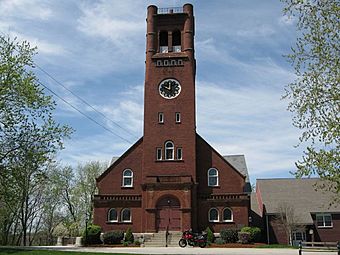Dudley Hill Historic District facts for kids
Quick facts for kids |
|
|
Dudley Hill Historic District
|
|

Conant Memorial Church
|
|
| Location | Center, Dudley Oxford Rd., Dudley Southbridge, Ramshorn & Tanyard Rds. Dudley, Massachusetts |
|---|---|
| NRHP reference No. | 100004707 |
| Added to NRHP | December 2, 2019 |
The Dudley Hill Historic District is a special area in Dudley, Massachusetts. It's like the historic heart of the town! This district stretches along Center Street. It's filled with old buildings, like homes, churches, and town buildings, that were built in the 1700s and 1800s. This area was one of the first places people settled in Dudley. It was added to the National Register of Historic Places in 2001 because of its important history.
Discovering Dudley Hill's History
The town of Dudley was created from land bought in 1681. This land was purchased from the Nipmuc people by Joseph Dudley and William Stoughton. However, people didn't start settling here until the 1720s. Dudley officially became a town in 1732.
Early Days on Dudley Hill
The area known as Dudley Hill was important even before the town was formed. It was a place where the Nipmuc people lived for a long time. In 1734, some land on Dudley Hill was given to build the town's very first church. After America became independent, the town center on Dudley Hill grew even more.
Important Buildings and Places
Dudley Hill is a long, narrow ridge that runs north to south. Center Street follows along this ridge. The historic district starts near Dudley Hill Road in the north and goes down to Tanyard Road in the south.
- The northern part of the district has the village cemetery.
- The southern part has the campus of Nichols College.
One of the most impressive buildings is the Conant Memorial Church. It was built with bricks in 1890. Next to the church, you can see the Italianate Grange hall. This building was first built around 1840 as a school. Across the street is the Black Tavern, which was built around 1803. It used to welcome travelers passing through.
Most of the old houses in the district are built in styles called Federal or Greek Revival. These styles were popular in the late 1700s and early 1800s. You can also find a couple of houses from the late 1800s built in the Stick style.



